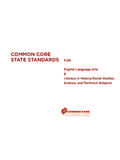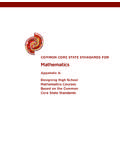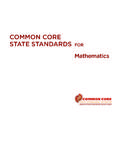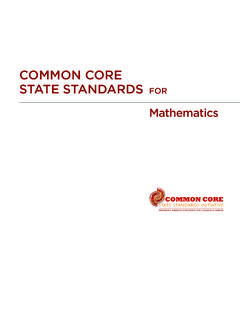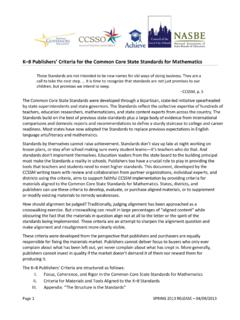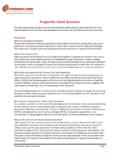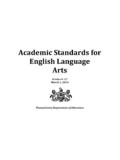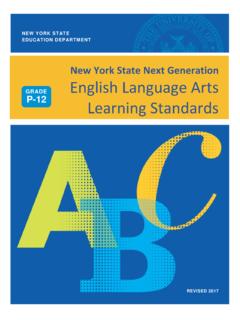Transcription of Revised Publishers Criteria for the Common Core State ...
1 1 Revised 4/12/2012 Revised Publishers Criteria for the Common Core State Standards in english language arts and Literacy, Grades 3 12 David Coleman Susan Pimentel INTRODUCTION Developed by two of the lead authors of the Common Core State Standards and Revised through conversations with teachers, researchers, and other stakeholders, these Criteria are designed to guide Publishers and curriculum developers as they work to ensure alignment with the standards in english language arts (ELA) and literacy for history/social studies, science, and technical subjects. The standards are the product of a State -led effort coordinated by the National Governors Association Center for Best Practices and the Council of Chief State School Officers and were developed in collaboration with teachers, school administrators, and experts to provide a clear and consistent framework to prepare students for college and the workforce. The Criteria articulated below concentrate on the most significant elements of the Common Core State Standards and lay out their implications for aligning materials with the standards.
2 These guidelines are not meant to dictate classroom practice but rather to help ensure that teachers receive effective tools. They are intended to guide teachers, curriculum developers, and Publishers to be purposeful and strategic in both what to include and what to exclude in instructional materials. By underscoring what matters most in the standards, the Criteria illustrate what shifts must take place in the next generation of curricula, including paring away elements that distract or are at odds with the Common Core State Standards. At the heart of these Criteria are instructions for shifting the focus of literacy instruction to center on careful examination of the text itself. In aligned materials, work in reading and writing (as well as speaking and listening) must center on the text under consideration. The standards focus on students reading closely to draw evidence and knowledge from the text and require students to read texts of adequate range and complexity.
3 The Criteria outlined below therefore revolve around the texts that students read and the kinds of questions students should address as they write and speak about them. The standards and these Criteria sharpen the focus on the close connection between comprehension of text and acquisition of knowledge. While the link between comprehension and knowledge in reading science and history texts is clear, the same principle applies to all reading. The Criteria make plain that developing students prowess at drawing knowledge from the text itself is the point of reading; reading well means gaining the maximum insight or knowledge possible from each source. Student knowledge drawn from the text is demonstrated when the student uses evidence from the text to support a claim about the text. Hence evidence and knowledge link directly to the text. 2 Revised 4/12/2012 DOCUMENT ORGANIZATION This document has two parts: The first articulates Criteria for ELA materials in grades 3 12 and the second for history/social studies, science, and technical materials in grades 6 12.
4 Each part contains sections discussing the following key Criteria : I. Key Criteria for Text Selection II. Key Criteria for Questions and Tasks III. Key Criteria for Academic Vocabulary IV. Key Criteria for Writing to Sources and Research The Criteria for ELA materials in grades 3 12 have one additional section: V. Additional Key Criteria for Student Reading, Writing, Listening, and Speaking 3 Revised 4/12/2012 ELA and Literacy Curricula, Grades 3-5; ELA Curricula, Grades 6 12 I. Key Criteria for Text Selection 1. Text Complexity: The Common Core State Standards require students to read increasingly complex texts with growing independence as they progress toward career and college readiness. A. Texts for each grade align with the complexity requirements outlined in the standards. Reading Standard 10 outlines the level of text complexity at which students need to demonstrate comprehension in each grade. (Appendix A in the Common Core State Standards gives further information on how text complexity can be measured and offers guidance to teachers and curriculum developers on selecting the texts their students read.)
5 1 Research makes clear that the complexity levels of the texts students are presently required to read are significantly below what is required to achieve college and career readiness. The Common Core State Standards hinge on students encountering appropriately complex texts at each grade level to develop the mature language skills and the conceptual knowledge they need for success in school and life. Instructional materials should also offer advanced texts to provide students at every grade with the opportunity to read texts beyond their current grade level to prepare them for the challenges of more complex text. B. All students (including those who are behind) have extensive opportunities to encounter grade-level complex text. Far too often, students who have fallen behind are only given less complex texts rather than the support they need to read texts at the appropriate level of complexity. Complex text is a rich repository of ideas, information, and experience which all readers should learn how to access, although some students will need more scaffolding to do so.
6 Curriculum developers and teachers have the flexibility to build progressions of texts of increasing complexity within grade-level bands that overlap to a limited degree with earlier bands ( , grades 4 5 and grades 6 8). Curriculum materials should provide extensive opportunities for all students in a classroom to engage with complex text, although students whose reading ability is developing at a slower rate also will need supplementary opportunities to read text they can comprehend successfully without extensive supports. These students may also need extra assistance with fluency practice and vocabulary building. Students who need additional assistance, however, must not miss out on essential practice and instruction their classmates are receiving to help them read closely, think deeply about texts, participate in thoughtful discussions, and gain knowledge of both words and the world. Some percentage of students will enter grade 3 or later grades without a command of foundational reading skills such as decoding.
7 It is essential for these students to have 1 A working group has developed clear, Common standards for measuring text complexity that are consistent across different curricula and Publishers . These measures blend quantitative and qualitative factors and are being widely shared and made available to Publishers and curriculum developers. The measures are based on the principles laid out in Appendix A and have been further developed and refined. These Criteria recognize the critical role that teachers play in text selection. 4 Revised 4/12/2012 age-appropriate materials to ensure that they receive the extensive training and practice in the foundational reading skills required to achieve fluency and comprehension. The K 2 Publishers Criteria more fully articulate the essential foundational skills all students need to decode to become fluent readers and comprehend text. C. Shorter, challenging texts that elicit close reading and re-reading are provided regularly at each grade.
8 The study of short texts is particularly useful to enable students at a wide range of reading levels to participate in the close analysis of more demanding text. The Common Core State Standards place a high priority on the close, sustained reading of complex text, beginning with Reading Standard 1. Such reading focuses on what lies within the four corners of the text. It often requires compact, short, self-contained texts that students can read and re-read deliberately and slowly to probe and ponder the meanings of individual words, the order in which sentences unfold, and the development of ideas over the course of the text. Reading in this manner allows students to fully understand informational texts as well as analyze works of literature effectively. D. Novels, plays, and other extended full-length readings are also provided with opportunities for close reading. Students should also be required to read texts of a range of lengths for a variety of purposes including several longer texts each year.
9 Discussion of extended or longer texts should span the entire text while also creating a series of questions that demonstrate how careful attention to specific passages within the text provide opportunities for close reading. Focusing on extended texts will enable students to develop the stamina and persistence they need to read and extract knowledge and insight from larger volumes of material. Not only do students need to be able to read closely, but they also need to be able to read larger volumes of text when necessary for research or other purposes. E. Additional materials aim to increase regular independent reading of texts that appeal to students interests while developing both their knowledge base and joy in reading. These materials should ensure that all students have daily opportunities to read texts of their choice on their own during and outside of the school day. Students need access to a wide range of materials on a variety of topics and genres both in their classrooms and in their school libraries to ensure that they have opportunities to independently read broadly and widely to build their knowledge, experience, and joy in reading.
10 Materials will need to include texts at students own reading level as well as texts with complexity levels that will challenge and motivate students. Texts should also vary in length and density, requiring students to slow down or read more quickly depending on their purpose for reading. In alignment with the standards and to acknowledge the range of students interests, these materials should include informational texts and literary nonfiction as well as literature. A variety of formats can also engage a wider range of students, such as high-quality newspaper and magazine articles as well as information-rich websites. 2. Range and Quality of Texts: The Common Core State Standards require a greater focus on informational text in elementary school and literary nonfiction in ELA classes in grades 6 12. 5 Revised 4/12/2012 A. In grades 3 5, literacy programs shift the balance of texts and instructional time to include equal measures of literary and informational texts.
